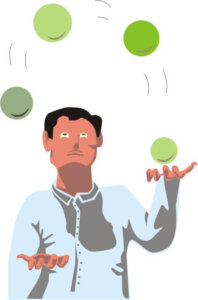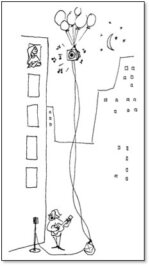Of all the ELT buzzwords I’ve heard, thought about and used over the past decade, noticing is by far the most frequent. Fortunately, noticing is nowhere near as broad and ambivalent as communicative, for example, which makes it much easier to pin down conceptually.
So, what is noticing, anyway, and how does it impact language learning?
Once upon a time, a linguist named Richard Schmidt decided to spend some time in Brazil to learn Portuguese. He recorded his interactions with Brazilians and kept a diary of what he had learned in class, through formal instruction, for five months. As it turns out, the words, phrases, and structures he had seen in class were easier to notice in his interactions with native speakers – they somehow stood out from the rest of the input and made noticing more likely. Schmidt also observed a significant correlation between the language he had actively noticed and the language he began to deploy spontaneously in communication. Schmidt then concluded that while noticing was clearly not enough for language learning (I tend to use the terms learning and acquisition interchangeably), it was a good starting point.
The use of the word actively before noticing is redundant, I know, but it stresses the fact that noticing entails paying conscious attention (oops, another redundancy) to what is said and how it is said. This, from a cognitive perspective, is a condition for successful language learning.
Now, imagine two non-native speakers having dinner with a group of American friends.
Speaker A: John’s an intermediate student of English. During the conversation, he seems to be able to understand a lot of what is said and can express himself fairly easily, too. Communication flows reasonably well and John’s perfectly happy to understand people and make himself understood – to get the job done, as it were.
Speaker B: Jack’s also fairly fluent and has good comprehension skills. However, during the conversation, he finds himself noticing things such as:
“What’s this whatever they use all the time?”
“How long did it take you… Interesting… I thought it was How long does it take you?”
“Regardless? What’s that?”
“Shoulda? What?”
“Oh, the woman used one of those complicated conditional sentences we saw in class.”
“Strange… develop? I thought it was develop.”
Unlike John, Jack was actively engaged in noticing elements of grammar, lexis and phonology in people’s speech. So if the data yielded by the Schmidt study is anything to go by, Jack’s more likely to acquire and internalize the new language in the long run by (a) being re-exposed to it over and over and re- noticing it and (b) giving it a try in spontaneous communication and receiving feedback. Both of these would, theoretically at least, contribute to interlanguage restructuring, another buzzword which is very closely related to noticing.

Now, since noticing involves conscious attention, and attentional resources are limited, it’s not surprising that only a limited number of language elements can get noticed at any given time – not least because this sort of detective-like mindset that noticing entails doesn’t come naturally to everyone. This means that language may be made more or less noticeable depending on:
1. Formal instruction
Students are more likely to notice language items they learn formally. So, in that sense, teaching, say, “wish” in class is only useful in so far as the student can go home, turn on the TV, and be re-exposed to “wish” being used in another context. This means that even though you might present and drill a piece of language till you’re blue in the face, it’s not the practice itself that will help students learn, but the amount of noticing generated by that practice – in other words, language learning can only begin in class. This is often referred to as the weak interface position. Let me make it clear, though, that I’m not yet ready to commit intellectually to this particular noticing hypothesis – I’m merely describing it.
2. Frequency and salience
The more often students hear or read a language item, the more likely it is to get noticed. For example, if you want students to notice, say, a certain word, phrase, or structure, you may consider using it in class yourself all the time or adapting texts in such a way that they’re “flooded” with the language to be noticed. This sort of “artificially engineered” noticing is often brought about by what we usually refer to as input flooding.
3. Noticing the gap
Students tend to notice language items that bridge some sort of gap they encountered while trying to convey their own ideas. So, say a student is struggling to tell the teacher that he or she will come to class on Monday regardless of the weather:
Student: “I will come … no problem the weather… rain or sun.”
Teacher: “Ok, so you’re coming regardless of the weather.”
Student: “Yes.”
The fact that regardless was offered as an alternative to “bridge the gap” makes noticing more likely. Bear in mind, though, that noticed does not mean acquired. The student in question would need several other encounters with the same word to re-notice it. At any rate, though, this sort of negotiation of meaning (often associated with the so-called “output hypothesis“) can also increase the noticeability of certain language items.
Incidentally, the words notice, noticing, noticed and noticeability were used nearly 20 times in this article. If it wasn’t for the use of green (which brought them to your conscious attention), I bet you wouldn’t have noticed that.
Thanks for reading.




Thank you for this, excellent for my own reflections on my teaching – I am convinced that part of what makes truly effective teaching is indeed helping form students into language ‘noticers’.
I remember my moment of wild joy snatched from the sometimes near despair of learning Spanish through total immersion- the giddy realisation “Maybe I *CAN* work this out!” , on realising just from the inflection of the way people were speaking that ‘pero’ must mean ‘but’. =)
Lucy, thanks for stopping by and for sharing the insights you derived from your own experience as a language learner.
Lucy, thank you. And thank you for sharing your experience learning Spanish.
I’m traveling through Costa Rica right now (I’m an American) and speak decent Spanish, and you’re right, noticing is a difficult but important part of the process.
Enjoy your trip, Chris, and come back and tell us about the experience in hindsight when you can!
Hello Luiz Otávio, congrats on your post! I’ve just finished the 2-month intensive Delta Course and ‘noticing’ was a concept which was discussed and read quite a few times during the course. It’s interesting how these expressions come up and become ‘trendy’ in ELT, right?
Your post was great and it gives teachers some background to this concept. I’ll try and post a few things from the DELTA in my blog later on. Are you going to BrazTesol or ABCI in July?
Eduardo
Hi, Eduardo
Thank you for your kind words. Yes, noticing is one of those ubiquitous terms, and it’s so intrinsically plausible (and central to a lot of what is done in ELT) that it’s probably more than just a passing fad. I’m glad you found it helpful.
I am definitely going to BrazTesol, but I still haven’t made up my mind if I’m going to be presenting or simply attending. I guess I have about a week to decide.
By the way, congratulations on your DELTA!
From my point of view, ‘noticing’ is definitely one of the most important things in ELT. Actually, I have been talking to some peers of mine about it for quite a long time– that’s the reason I ended up here on your blog again, because I knew I had seen something about the topic on it. In fact, I read it a lot – needless to say that it is a great one. Congratulations on your post.
Bruno, thank you very much for your kind words!
So an article on noticing with input enhancement (highlighting the words in green)? 🙂
Re your point #1 I am becoming more and more interested in – and convinced about – the priming effect of formal instruction, when learning begins in class and continues elsewhere.
L
Thanks, Leo.
So am I, though not as much as perhaps I would be if I taught in an ESL context, where there’s far more input outside the classroom.
It’s the role of practice (output) that still gives me nightmares. How does declarative knowledge become procedural knowledge? Is it the practice itself? Or is it the amount of noticing (+ subsequent re-exposure) generated by that practice? As I said, while it’s true that ”
practice makes perfect” perhaps doesn’t apply to language learning as neatly as it does to, say, learning a musical instrument, I’m not ready to dismiss output-oriented practice out of hand just yet.
And if you throw memory (and its role in the learning of pre-fabricated, chunky language) in the mix, things get even more complicated.
Anyway, thanks for stopping by! 🙂